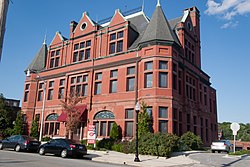
Mount Vernon is a neighborhood immediately north of downtown Baltimore, Maryland. Designated a National Historic Landmark District and a city Cultural District, it is one of the city's oldest neighborhoods and originally was home to the city's wealthiest and most fashionable families. The name derives from the Mount Vernon home of George Washington; the original Washington Monument, a massive pillar commenced in 1815 to commemorate the first president of the United States, is the defining feature of the neighborhood.
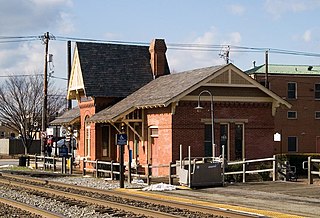
Gaithersburg station is a commuter rail station located on the Metropolitan Subdivision in downtown Gaithersburg, Maryland. It is served by the MARC Brunswick Line service; it was also served by Amtrak from 1971 to 1986. The former Baltimore and Ohio Railroad station building and freight shed, designed by Ephraim Francis Baldwin and built in 1884, are listed on the National Register of Historic Places as Gaithersburg B & O Railroad Station and Freight Shed. They are used as the Gaithersburg Community Museum.
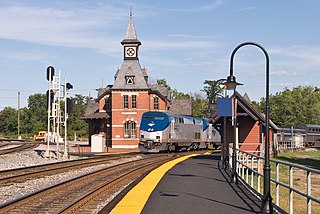
Point of Rocks is a historic passenger rail station on the MARC Brunswick Line between Washington, D.C., and Martinsburg, WV, located at Point of Rocks, Frederick County, Maryland, United States. The station was built by the Baltimore and Ohio Railroad in 1873, and designed by E. Francis Baldwin. It is situated at the junction of the B&O Old Main Line and the Metropolitan Branch. The Met Branch also opened in 1873 and became the principal route for passenger trains between Baltimore, Washington and points west.

Laurel is a historic passenger rail station on the MARC Camden Line in Laurel, Maryland, between the District of Columbia's Washington Union Station and Baltimore's Camden Station.
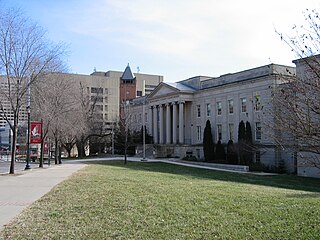
The Montgomery County Circuit Courthouses are part of the Montgomery County Judicial Center located in downtown Rockville, Maryland. The Red Brick Courthouse, located at 29 Courthouse Square, houses the refurbished Grand Courtroom; the newer Circuit Court building, located at 50 Maryland Avenue, houses the remainder of the county's justice system.

Mount Clare, also known as Mount Clare Mansion and generally known today as the Mount Clare Museum House, is the oldest Colonial-era structure in the City of Baltimore, Maryland, U.S.A. The Georgian style of architecture plantation house exhibits a somewhat altered five-part plan. It was built on a Carroll family plantation beginning in 1763 by barrister Charles Carroll the Barrister, (1723–1783), a descendant of the last Gaelic Lords of Éile in Ireland and a distant relative of the much better-known Charles Carroll of Carrollton, (1737–1832), longest living signer of the Declaration of Independence and the richest man in America in his later years, also the layer of the First Stone of the new Baltimore and Ohio Railroad, just a short distance away in 1828.
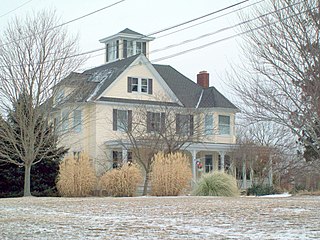
Linnwood, is a historic home located at Ellicott City, Howard County, Maryland, United States. It is a large 1901 Queen Anne-influenced house consisting of a 2+1⁄2-story four-bay by four-bay frame structure with vinyl siding, a rubble stone foundation, and a hip roof with asphalt shingles. Six domestic outbuildings are arrayed behind the house, including a springhouse/greenhouse, shop building/cold storage and annex, garage, smokehouse, privy, and a modern garage. A stone gateway with iron gates is located at the road, flanking the driveway. The house's Late Victorian form and appearance resulted from a thorough remodeling in 1901 of a preexisting farmhouse, according to designs by architect D. S. Hopkins.

The Chesapeake Beach railway station is a historic railway station located at Chesapeake Beach, Calvert County, Maryland, United States. It is composed of two one-story, hip-roofed sections; one part was once an open passenger boarding area that was later enclosed for storage. The station was erected in 1898, for the Chesapeake Beach Railway. It is now operated as a railway museum.

The Inns on the National Road is a national historic district near Cumberland, Allegany County, Maryland. It originally consisted of 11 Maryland inns on the National Road and located in Allegany and Garrett counties. Those that remain stand as the physical remains of the almost-legendary hospitality offered on this well-traveled route to the west.
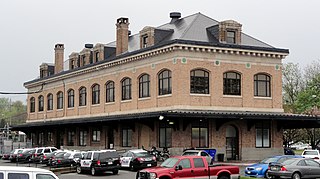
Hagerstown station is a historic railway station in Hagerstown, Washington County, Maryland. It was built in 1913 as a stop for the Western Maryland Railway. It is a 2+1⁄2-story hip roof brick building, reflecting the influence of the Commercial Style of the early 20th century. The building features overscaled classical detailing, a stone foundation, and a massive, modillioned cornice with stone disks defining each bay. The building is also encircled by a one-story porch that has a cantilevered roof on three sides.

Creagerstown is an unincorporated community in Frederick County, Maryland, United States. It is playfully known by its residents as "4 miles from everywhere" because of its situation at 4 miles (6.4 km) from Thurmont, Woodsboro, Rocky Ridge, and Lewistown.

Southern District Police Station is a historic police station located at Baltimore, Maryland, United States. It is a monumental Romanesque Revival steel-framed building faced in stone and brick constructed in 1896. The station is composed of a three-story cubic main block, a two-story rear ell, and two additions built in the 1950s that fill most of the remainder of the corner lot.

Old Pine Street Station, also known as the Old Western District Police Station House, is a historic police station located at Baltimore, Maryland, United States. It is a freestanding brick building of two stories raised on a partially exposed basement in the quintessential brick Victorian Gothic style. It was constructed 1877–78.

Ruscombe is a historic home located at Baltimore, Maryland, United States. It is a 2+1⁄2-story Italianate mansion with basement, constructed of fieldstone in 1866. It is a gable and hip roofed building. The main block of the building is 50 feet by 50 feet, with a gable-roofed L-shaped wing. It was designed by Baltimore architect Joseph F. Kemp, who is credited with the design of Camden Station.
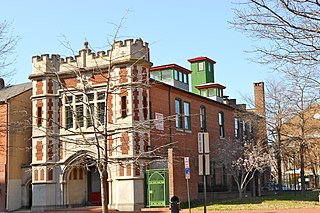
Poppleton Fire Station, also known as Engine House #38, is a historic fire station located at Baltimore, Maryland, United States. It is a Tudor Revival style building built of brick, one large bay wide, approximately nine bays long, and two stories high with a gable roof. The front façade is a brick and limestone composition featuring a central, Tudor archway flanked by octagonal towers and crowned with crenellation. The archway features engaged colonettes with carved, foliated capitals containing firemen racing to extinguish a fire. It was designed by Owens and Sisco and built in 1910.

Hendler Creamery is a historic industrial complex in Jonestown, Baltimore, Maryland. Since it spans an entire block it has addresses at 1100 E. Baltimore St. and 1107 E. Fayette St. "The Hendler Creamery is historically significant for its contribution to the broad patterns of history in three areas of significance: transportation, performing arts, and industry."
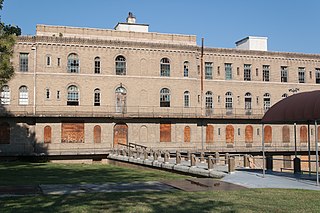
Sydenham Hospital for Communicable Diseases, also known as Montebello State Hospital or Montebello State Chronic Disease Hospital, was a hospital and is a national historic district in Baltimore, Maryland, United States. It was originally constructed in 1922–1924, and the campus consists of seven Italian Renaissance Revival style buildings: the main hospital building, the administration building, the kitchen, the nurses’ home, the laundry with servants’ quarters above, the garage, and the powerhouse. A residence for the Director of Medical Research was added in 1939. The campus was designed by noted Baltimore architect Edward Hughes Glidden.

The former Eighth Precinct Police Station is a building located at 4150 Grand River Avenue in the Woodbridge Historic District of Detroit, Michigan. It is the second-oldest police building in Detroit, and was designated a Michigan State Historic Site in 1973 and listed on the National Register of Historic Places in 1974. The building now houses the Detroit Castle Lofts.
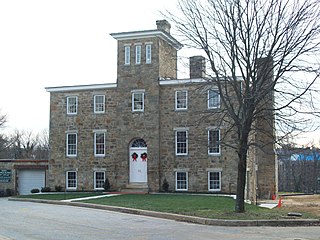
Baltimore County Jail is a historic jail located at Towson in Baltimore County, Maryland, United States. It was built in 1855 and is a two-story Italianate style stone building, measuring 52 feet wide and 62 feet deep. It consists of a five-bay-wide warden’s house with a central three story entry tower. In the rear is a cell block with three levels of jail cells and covered by a gable roof. The warden's house and tower features a low pyramidal hipped roof and 30-inch-thick (760 mm) walls. Attached to the warden's house is a stone garage built in 1940. It was used as a correctional facility until 2006.

The Justice and Police Museum is a heritage-listed former water police station, offices and courthouse and now justice and police museum located at 4-8 Phillip Street on the corner of Albert Street, in the Sydney central business district in the City of Sydney local government area of New South Wales, Australia. It was designed by Edmund Blacket, Alexander Dawson and James Barnet and built from 1854 to 1886. It is also known as Police Station & Law Courts (former) and Traffic Court. The property is owned by the Department of Justice, a department of the Government of New South Wales. It was added to the New South Wales State Heritage Register on 2 April 1999.
